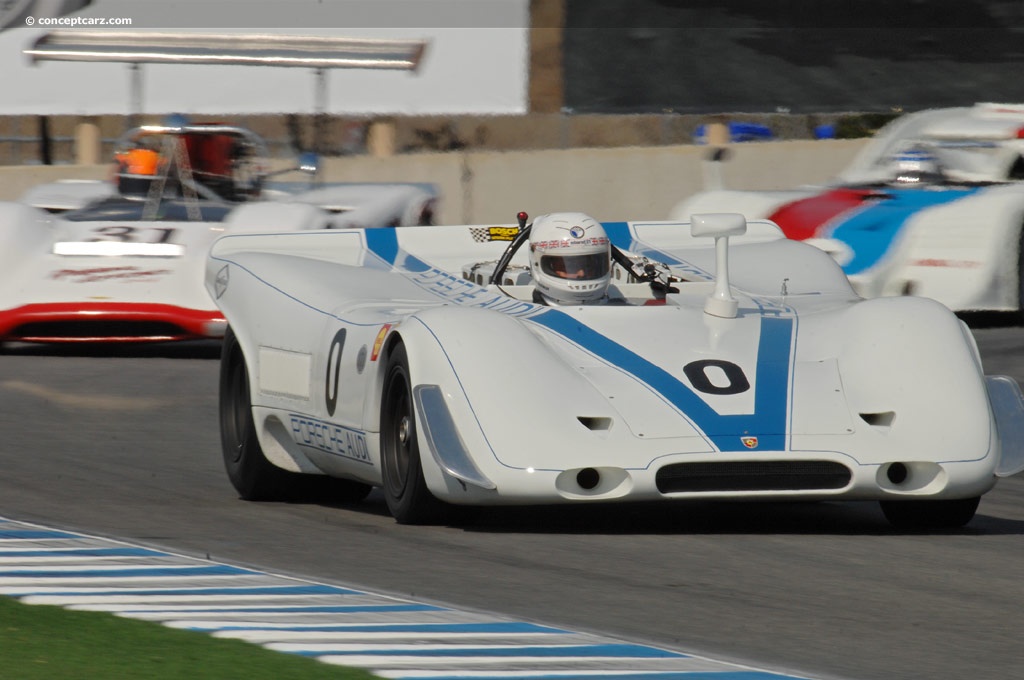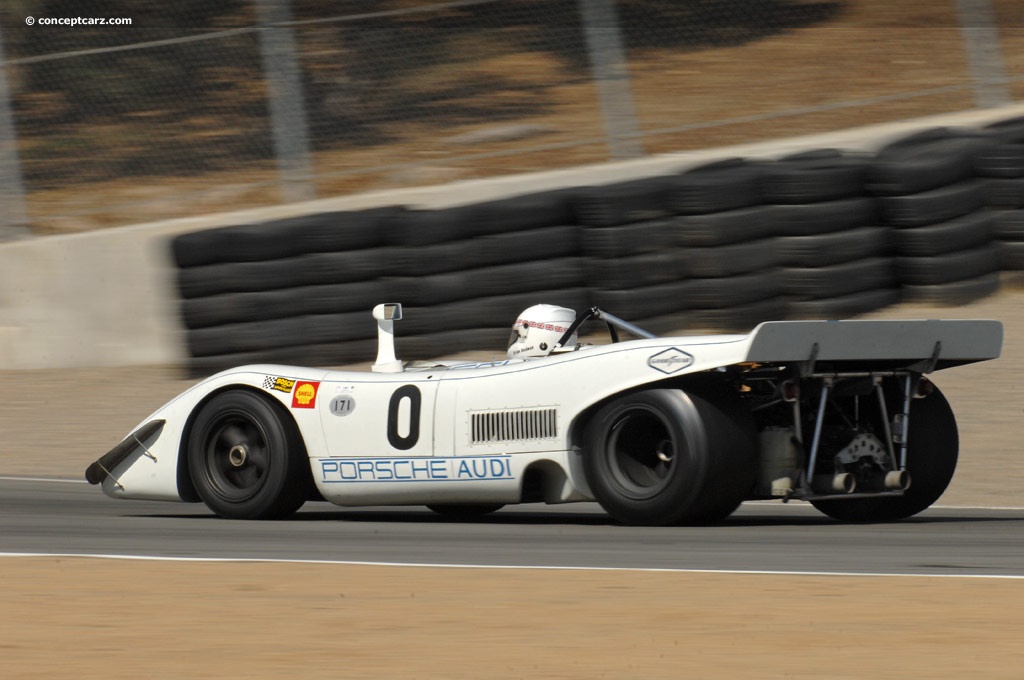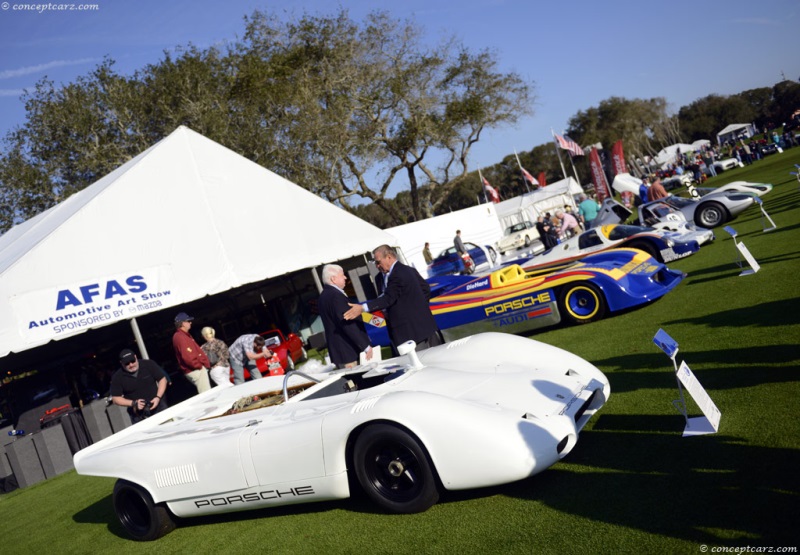Forty years ago on March 13, 1969 at the Geneva International Motor Show, today's Dr. Ing. h.c. F. Porsche unveiled a car that, even by today's standards, is underestimated when it is described as the 'super sports car': The Porsche 917. It became a legend as one of the fastest and most successful racing cars of all time. 
Spyder
Chassis #: 917.028
View info and historyPorsche fired the starting shot for Project 917 in June 1968, after the international motor sports authority or FIA had announced a class of 'homologated sports cars' with up to five liters cubic capacity and a minimum weight of 800 kilograms. Under the supervision of Ferdinand Piëch, the stipulated 25 units of the new racing car model were completed by April 1969 so that the 917 could begin its racing career in the same year. After it initially dropped out of its first three races due to technical problems, the 917 success story began in August 1969 at a 1,000-kilometer race at the Österreichring with a victory by Jo Siffert and Kurt Ahrens.The engine configuration of the 917 was just as unusual as its different car body versions: Behind the driver's seat extended an air-cooled, twelve-cylinder engine with horizontal cylinders, whose crankshaft designated it as a 180-degree V engine. The 520 HP engine had an initial cubic capacity of 4.5 liters. The tubular frame was made of aluminum, the car body out of glass fiber reinforced synthetics. Porsche engineers developed different car body models to best meet the different demands of different racetracks. The so-called short-tail model was designed for heavily twisting roads in which a high contact pressure was necessary for fast cornering. The long-tail model was designed for fast racetracks and a high final velocity. Then came the open 917 Spyders, which were used in the CanAm and Interseries races.At the end of the 1970 race season, Porsche confirmed its superiority with the 917 and 908/03 models, winning the Racing Series World Championship Markenweltmeisterschaft in nine out of ten possible victories. This series of victories began in Daytona and continued in Brands Hatch, Monza, Spa, on the Nürburgring racetrack, at the Targa Florio, in Le Mans, Watkins Glen and the Österreichring. However, the season's high point was the long-desired overall win of the Le Mans 24-hour endurance race, a trophy that Hans Herrmann and Richard Attwood brought home to Zuffenhausen on June 14, 1970. Their 917 short-tail model painted in the Porsche Salzburg colors of red and white with the start number 23 not only successfully defied its competitors but also the heavy rainfall.
Spyder
Chassis #: 917.028
View info and historyAs in the previous year, the 1971 season was dominated by the 917 model so that the Racing Series World Championship Markenweltmeisterschaft went to Porsche again with eight out of ten race victories. And once again, a Porsche 917 was victorious at the Le Mans 24-Hour race – this time with Gijs van Lennep and Dr. Helmut Marko, who set a world record with an average speed of 222 km/h and 5,335 kilometers driven, a record that still stands today. One special feature of their 917 short-tail model, visually characterized by its 'shark fin', was the tubular frame made of magnesium. A 917 long-tail coupe model set a further record in 1971: On the Mulsanne straight stretch, which is part of the route in the Le Mans 24-Hour race, the sports car with the start number 21 recorded the highest speed of 387 kilometers per hour. Another Le Mans racecar achieved major recognition: The Porsche 917/20 was a mix between the short-tail and the long-tail models and was notable for its broad proportions. Although the pink colored racecar, nicknamed 'the Pig', dropped out halfway through the race, its unusual paint color made it one of the most famous Porsche models ever.When the European FIA regulation for the 'five-liter sports car' expired at the end of the 1971 season, Porsche decided to enter the Canadian American Challenge Cup (CanAm). In June 1972, the private Penske race team in motor sports used the turbo-charged Porsche 917/10 Spyder for the first time. With a performance of up to 1,000 HP, the Porsche Spyder dominated the race series and won for Porsche the CanAM championship with victories in Road Atlanta, Mid Ohio, Elkhart Lake, Laguna Seca and Riverside. In the following year, the 1,200 HP 917/30 Spyder had its racing premiere. The superiority of the monster car driven by Mark Donohue was so obvious that the regulations of the CanAM series had to be changed in the end in order to exclude the 917/30 from competing further in the 1974 season. Typical for Porsche: The technologies for increasing performance developed for these races were successfully transferred to the on-road sports car. That's how the 911 Turbo, with its side-exhaust turbocharger, began its career in 1974 and has been, since this time, a synonym for the performance capacity of the Porsche sports car.To date, the reputation of the 917 is legendary. Therefore, 50 international motor sports experts from the famous British trade magazine 'Motor Sport' nominated the 917 as the 'greatest racing car in history'. All in all, Porsche built 65 units of the 917: 44 sports cars as short-tail and long-tail coupés, two PA Spyders as well as 19 sports cars as CanAm and Interseries Spyders with up to 1,400 HP turbo engines. Seven of the most important 917 models – among them the Le Mans victory cars from 1970 and 1971 and the 917/30 Spyder – are currently on exhibit in the new Porsche Museum in Stuttgart-Zuffenhausen.Source - Porsche

Spyder
Chassis #: 917.028
View info and history

Spyder
Chassis #: 917.028
View info and history
Related Reading : Porsche 917 History
In July of 1968 Porsche began designing and building a new prototype for the Sport category. The FIA changed the regulations of the Sport category to allow vehicles with 5-liter engines, up from the prior 3-liter capacity. Instead of 50 examples, only 25 examples needed to be produced to satisfy homologation rules. With the 917, Porsche had high hopes for capturing an overall victory at the grueling....
Continue Reading >>
Continue Reading >>
1969 Porsche 917 Vehicle Profiles
Recent Vehicle Additions
Related Automotive News

1969 24 Hours of Le Mans: A Traditional Statement Provides a Memorable Race
What if a statement ended up costing one of the biggest victories of ones career Would it be worth it Jacky Ickx would come close to finding out as he approached the checkered flag on the afternoon of the 15th of June in 1969.
Ford had determined...

Singer Presents Dynamics & Lightweighting Study - Turbo
Singers latest restoration services offered to enthusiast owners of the Type 964 air-cooled 911
Turbocharging integrated with the results of the Dynamics %26 Lightweighting Study (DLS)
Personalized at the request of Singers clients for road or tr...

From Lucybelle to DHL: Historic Porsche Competition Cars Race to Gooding & Company's Pebble Beach Auctions
The very best of Porsche excellence will come to Pebble Beach with a 1959 Porsche 718 RSK, a 1969 Porsche 90802, a 2007 Porsche RS Spyder Evo, and more.
Gooding %26 Company, the official auction house of the Pebble Beach Concours dElegance®,...
Bruce McLaren's 'Buried Treasure' Unearthed After 57 Years
Legendary Jolly Green Giant The Very First McLaren Badged Car, Revealed at Bonhams
One of motor racings most legendary classic sports-racing cars, Bruce McLarens 1964 Cooper-Zerex-Oldsmobile Jolly Green Giant – which became something of...

Record Breaking Porsche 919 Evo Meets Its Legendary Predecessor 917/30
A 2,400-hp summit at the Rennsport Reunion VI in California
Stuttgart. At its final huge public appearance on the 919 Tribute Tour, the record breaking Porsche 919 Hybrid Evo meets a historic counterpart – the Porsche 91730 from 1973....

2015 GENEVA MOTOR SHOW
Geneva 2015 Mazdas unbridled potential
Mazda is coming off another successful year in Europe in 2014. Theres no let-up in sight either, as demonstrated by the companys aggressive model offensive five launches in six months.
All are on...












































